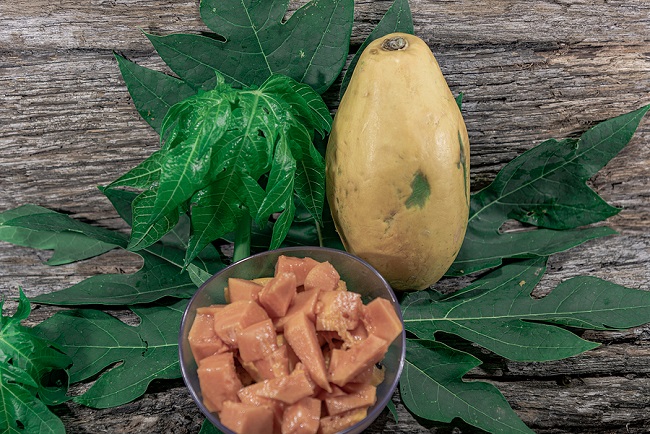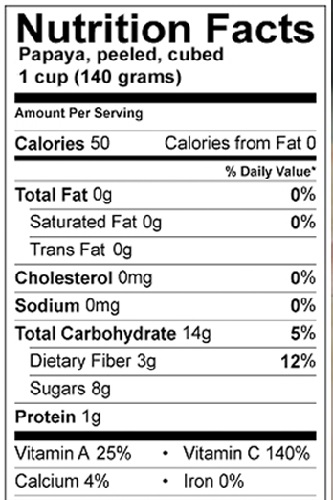- Home
- Food Questions
- Papaya
Is Papaya Ok on The Candida Diet?
Updated 6/24/2022
Written by Dr. Brittany Buysschaert, PhD
A tropical delight, papayas (Carica papaya) are the fruit of the papaya tree. Technically a berry, papayas can be eaten either ripe with orange or yellow flesh or unripe with green flesh. Papayas are called pawpaws in many parts of the world. There are about two dozen kinds of papaya. The most popular varieties of papaya sold in the US are Sunrise and Maradol.
Papayas originated in the region consisting of northern South America, Central America, and Mexico. They can only be grown in areas with subtropical or tropical climates due to their frost sensitivity. Temperatures below freezing can kill papaya plants if they are not properly protected. Unripe papayas have green flesh, are not sweet, and are typically used in savory dishes either cooked or raw. Green papayas are most commonly eaten in Southeast Asian cuisine. Ripe papayas have orange or yellow flesh, are sweet, and are typically eaten raw. Green papaya is high in an enzyme called papain, which is used as a meat tenderizer. Papaya leaves can be cooked and eaten like a green vegetable, or may be further processed into nutraceutical powders with health benefits.
Papayas are susceptible to a number of diseases. The most significant of these is papaya ringspot virus. This virus eventually kills papaya plants and devastated the once vigorous Hawaiian papaya production in the 1990s. As a result of the ringspot virus, genetically modified papaya cultivars resistant to this virus were created. Over 13 million metric tons of papaya are produced globally each year, led by India. India grows 45% of the world’s papayas with 6 million metric tons. Mexico is the world’s largest exporter, shipping approximately 160,000 metric tons of papaya each year for 34% of the world’s total exports.

Nutrient Profile of Papaya
One cup (165 grams) of ripe papaya contains approximately 70 calories. It also contains fiber, Vitamin C, and folate in significant quantities. Carbohydrates, mostly simple sugars, are the primary nutritional component of papayas.
Carbohydrates
Papaya contains 18 grams of carbohydates per serving. This includes 13 grams of sugar. As it is rich in natural sugar, eating papaya can be a healthy energy boosting snack. The glycemic load of papaya is low at 6.4 per 1 cup, and its vitamin and fiber content make it a healthy choice despite containing some sugar.
Fibers
Papaya contains 3 grams of fiber per serving. Papayas contain both soluble and insoluble dietary fiber, with about 60% of the fiber being insoluble (1). Insoluble fiber can be helpful in preventing constipation and promotes regular bowel movements. Soluble fiber also aids in healthy bowel movements, can help lower cholesterol, and helps diabetics maintain blood glucose levels.
Proteins
Papaya is not a significant source of protein, with 1 gram of protein per serving.
Fats
Papaya is not a significant source of fat, with 0.5 grams of fat per serving.
Vitamins and Minerals
The most prevalent vitamins in papaya are Vitamin C and folate. Papaya is an excellent source of Vitamin C, with 110% of the FDA recommended daily value in each serving. It is also a good source of folate, with 15% of the FDA recommended daily value in each serving. Papaya is not a significant source of minerals.
Antioxidants in Papaya
Phenolic Compounds
Green papaya is a rich source of phenolic compounds, including caffeic acid, p-coumaric acid, and ferulic acid (2). These phenolic compounds are known to have immunomodulatory and antimicrobial activity (3). Papaya leaves have many reported health benefits. Green leaves from papayas contain alkaloids, phenolic compounds, amino acids, and flavonoids (4). Kamepferol is the major antioxidant flavonoid found in papaya leaves, along with significant quantities of quercetin (4).Kamepferol can reduce the risk of chronic diseases, particularly cancer (5). This is because kamepferol aids in the body’s defense against free radicals, which promote cancer development. Quercetin not only shows anticancer benefits but also has antiviral and anti-inflammatory activities (6). Powdered extracts of papaya leaves contain approximately 6% polyphenols and can be used as dietary supplements (7).
Carotenoids
Bioactive carotenoids, including B-carotene and lycopene, increase with ripening in papayas. These compounds are what gives papaya flesh its orange or yellow color. Thus, riper papaya contains more bioactive compounds than green papaya (8). The B-carotene in papaya is highly bioavailable (9). The bioavailability in papaya is more than three times higher than B-carotene bioavailability carrots (9), another B-carotene rich food.
Health Benefits of Papaya
Gastrointestinal Benefits
Papaya fruit has long been used in traditional medicine for gastrointestinal ailments. Papaya contains significant amounts of latex, which aids in bowel movements (10). Green papayas can be tapped for a milk sap high in papain. This milk sap which has been utilized for indigestion (10). Papaya seeds can be eaten to eliminate some parasitic infections (10).
Topical Benefits
Papaya peel has multiple benefits when applied directly to the skin. Papaya peel extract can be used as sunscreen (10). The peel has also been used directly as a dressing for ulcers and burns (11). The enzyme papain found in the peel dissolves non-living tissue without affecting living cells, prevents infection of burn wounds, and creates an excellent environment for new skin to be grafted upon (12).
Benefits to Diabetics
Products derived from the fermentation of papaya fruit may be beneficial to diabetics. Juice from the an unripe green papaya is extracted, fermented, and turned into a powder. This fermented powder has anti-inflammatory and antioxidative effects (12). Some conditions resulting from diabetes are caused by inflammation and oxidative stress. Thus, products derived from fermented papaya fruit could be useful in managing long term health for diabetics.
Anticancer Benefits
Cancer patients may choose to utilize herbal remedies as part of their treatment, and fermented papaya powder is a common functional food consumed by individuals with cancer (12). Fermented papaya powder was successful in reducing tumor size and malignancy incidence in mice (13) but hasn’t yet been tested in humans.
Negative Health Effects of Papaya
Although uncommon, individuals can be allergic to papaya, particualarly raw papaya. Raw papaya contains latex, which could cause an allergic reaction in sensitive individuals. The enzyme papain is derived from papaya latex. Papain can be utilized as an ingredient in meat tenderizers, so individuals with a papaya allergy may also be allergic to some meat tenderizers.
Papaya and The Candida Diet
The following nutrition information is provided by the USDA for 1 cup (145g) of raw papaya sliced into one-inch cubes.
- Calories: 62
- Fat: 0.4g
- Sodium: 11.6mg
- Carbohydrates: 16g
- Fiber: 2.5g
- Sugars: 11g
- Protein: 0.7g

16 grams of carbs is more than acceptable but the 11g of sugar is cause for concern. The glycemic index of papaya is 60 which is in the high range. Glycemic load is 9, which is not to bad.
Looking at the label on the right you see 1 cup peeled papaya comes in at 14g of carbs and 8g of sugar. The 3 grams of dietary fiber helps slow down the absorption of carbs into the blood stream. The glycemic load of 9 is on the high side of low, scale is 1-10, so that is helpful.
You can't cut off all carbs on the Candida yeast diet because doing so deprives your red and white blood cells of fuel. So we suggest you limit your servings of papaya to ½ a cup or even a ¼ cup, treat it like a snack or desert. That way the carb load is down to 7 or 8g which is similar to most berries, which are generally allowed on the Candida diet. Sugars would be down to 4g which is not going to spike your blood sugar.
Back to Candida Diet Questions
If you have any questions about papaya and the Candida diet or about yeast infections in general, please feel free to contact us from the contact page of this website or see your doctor.
Medical References
1. Velderrain-Rodriguez, G., Quiros-Sauceda, A., Mercado-Mercado, G., Ayala-Zavala, J. F., Astiazaran-Garcia, H., Robles-Sanchez, R. M., Wall-Medano, A., Sayago-Ayerdi, S., Gonzales-Aguilar, G. A. (2016). Effect of dietary fiber on the bioaccessibility of phenolic compounds of mango, papaya, and pineapple fruits by an in vivo digestion model. Food Science and Technology, 36(2), 188-194.
2. Gayosso-Garcia Sancho, L. E., Yahia, E. M., & Gonzalez-Aguilar, G. A. (2011). Identification and quantification of phenols, carotenoids, and Vitamin C from papaya (Carica papaya L., cv. Maradol) fruit determined by HPLC-DAD-MS/MS-ESI. Food Research International, 44(5), 1284-1291.
3. Heena, D. & Sunil, T. (2019). Carica papaya: Potential implications in human health. Current Traditional Medicine, 5, 321-336
4. Nugroho, A., Heyrani, H., Choi, J. S., Park. H.-J. (2017). Identification and quantification of flavonoids in Carica papaya leaf and peroxynitrite-scavenging activity. Asia Pacific Journal of Tropic Biomedicine. 7(3), 208-213.
5. Chen, A. Y., & Chen, Y. C. (2012). A review of the dietary flavonoid, kaempferol on human health and cancer chemoprevention. Food Chemistry, 138(4), 2099-2107.
6. Li, Y., Yao, J., Han, C., Yang, J., Chaudhry, M. T., Wang, S., Liu, H., & Yin, Y. (2016). Quercetin,inflammation and immunity. Nutrients, 8(3), 167.
7. Vuong, Q. V., Hirun, S., Roach, P. D., Bowyer, M. C., Phillips, P. A., Scarlett, C. J. (2013). Effect of extraction conditions on total phenolic compounds and antioxidant activities of Carica papaya leaf aqueous extracts. Journal of Herbal Medicine, 3(3), 104-111.
8. Akhila, S. & Vijayalakshmi, N. G. (2015). Phytochemical studies on Carica papaya leaf juice. International Journal of Pharmaceutical Sciences and Research. 6(2), 880-883.
9. Schweiggert, R., Kopec, R., Villalobos-Gutierrez, M., Högel, J., Quesada, S., Esquivel, P., . . . Carle, R. (2014). Carotenoids are more bioavailable from papaya than from tomato and carrot in humans: A randomised cross-over study. British Journal of Nutrition, 111(3), 490-498. doi:10.1017/S0007114513002596
10. Yogiraj, V., Goyal, P. K., Chauhan, C. S., Goyal, A., & Vyas, B. (2014). Carica papaya Linn: An overview. International Journal of Herbal Medicine, 2(5), 1-8.
11. Krishna, K. L., Paradhavi, M., Patel, J. A. (2008). Review on nutritional, medicinal, and pharmacological properties of papaya (Carica papaya Linn.). Natural Product Radiance, 7(4), 364-373.
12. Murakami S, Eikawa S, Kaya S, Imao M, Aji T. (2016). Anti-tumor and immunoregulatory effects of fermented papaya preparation (FPP: SAIDOPS501). Asian Pacific Journal of Cancer Prevention, 17(7), 3077-84.
13. Otsuki, N., Dang, N. H., Kumagai, E., Kondo, A., Iwata, S., & Morimoto, C. (2010). Aqueous extract of Carica papaya leaves exhibits anti-tumor activity and immunomodulatory effects. Journal of Ethnopharmacology, 127(3), 760–767.
Home Privacy Policy Copyright Policy Disclosure Policy Doctors Store
Copyright © 2003 - 2025. All Rights Reserved under USC Title 17. Do not copy
content from the pages of this website without our expressed written consent.
To do so is Plagiarism, Not Fair Use, is Illegal, and a violation of the
The Digital Millennium Copyright Act of 1998.